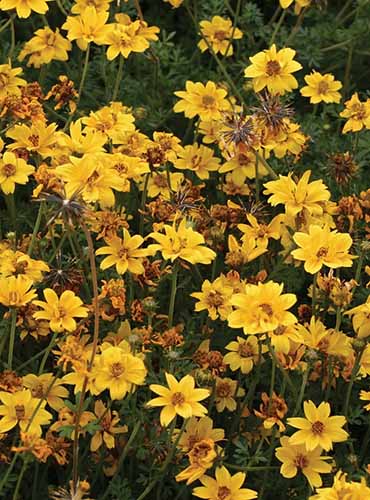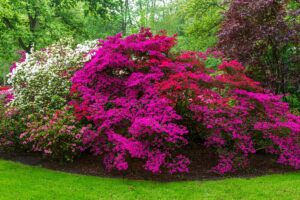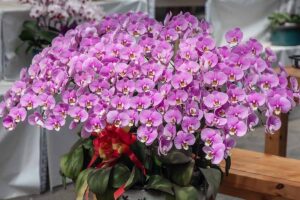Bidens spp.
The name Bidens may not be a familiar one, but the sight of them surely is.
While creating dazzling displays in the ground and in containers, Bidens species and cultivars also provide bountiful blooms for pollinators to forage nectar and pollen from.
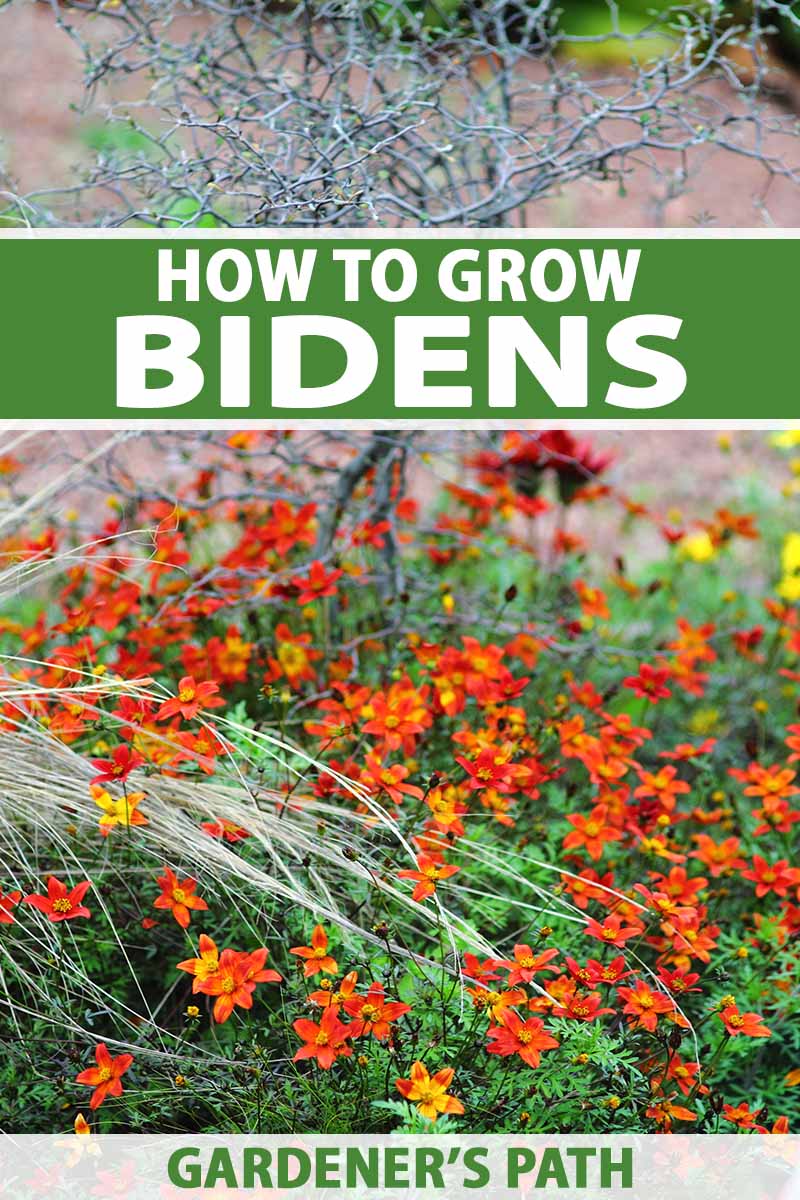
We link to vendors to help you find relevant products. If you buy from one of our links, we may earn a commission.
Their sun-loving character makes them great additions to drought-tolerant landscapes, adding long-lasting bursts of color.
Bidens come in a range of hues reminiscent of a summer campfire: red, orange, peach, and yellow, as well as pink and white.
They grow harmoniously with other plants, making them popular for container plant combinations. Their blooms spill over raised beds and create beautiful cascades of color in hanging baskets and containers.
Thanks to their versatility and ability to remain compact, they are easy to care for and grow in any size garden.
Plant Bidens to enhance a verdant view and diversify the flower color spectrum in your garden.
Create a serene space by decorating your balcony, patio, or terrace with these lightly fragrant flowers that attract pollinators.
Here’s everything you need to know, plus a little more, about how to grow Bidens.
What You’ll Learn
Many native Bidens species still grow in their habitat of origin and have also naturalized in areas outside their indigenous range.
Some species can be over-opportunistic when growing in the wild, and others are happily invited into gardens and landscapes.
Let’s clarify some of the species’ confusion.
Cultivation and History
Bidens are short-lived perennials and annuals in the Asteraceae family. There are approximately 220 accepted species in the genus today.
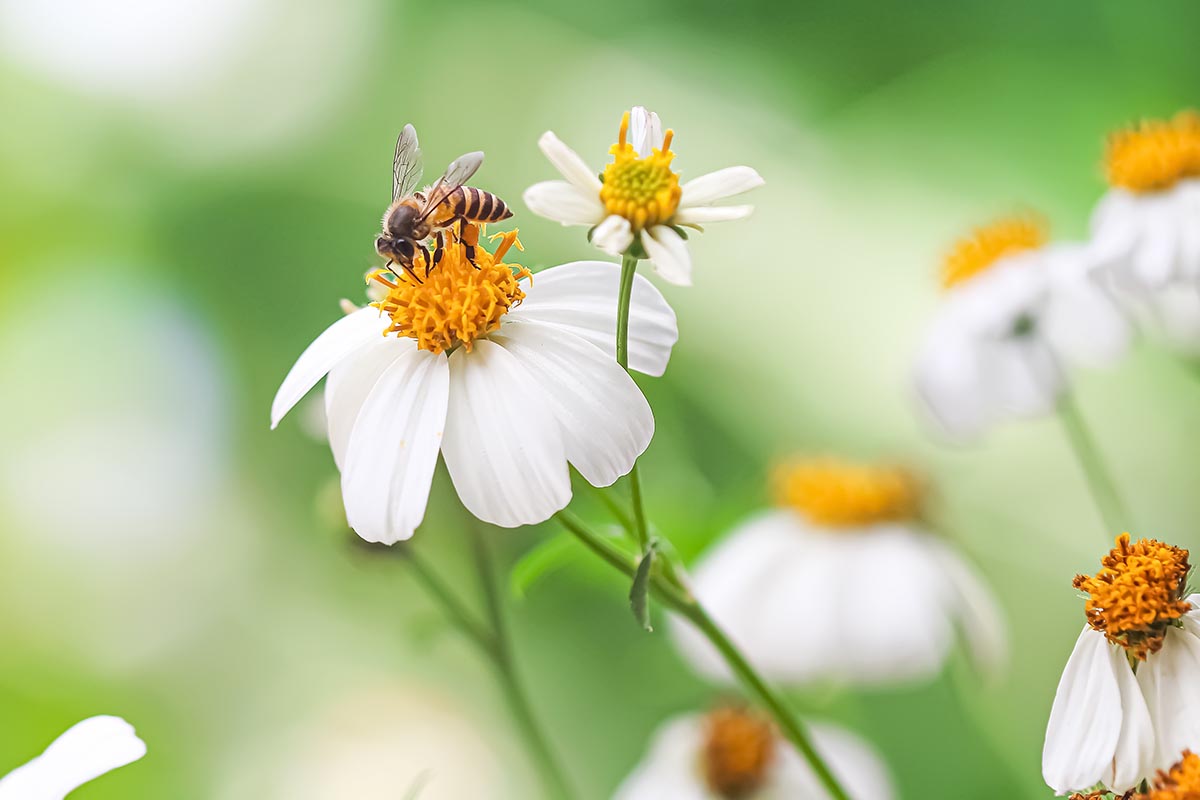
Most Bidens have daisy-like petals that surround tiny yellow tubular disk florets. Some petals are long, some are short, and some species have no petals at all! Their foliage is green, and the leaf structure can vary depending on the species.
Bidens is genuinely a global plant genus! Members of the genus are native to Africa, Central America, North America, South America, Asia, and Europe.
They thrive in warm and tropical regions. In colder climates, they are considered annuals, and in Zones 8 to 11, Bidens may be grown as short-lived perennials.
The name of the genus is derived from the Latin bis, meaning two, and dens, which translates to tooth in English, referring to the fruiting head with two sharp pappi or modified calyxes at the tip, which resemble “two teeth.”

The many common names that Bidens go by can lead to confusion between one species and the next.
Beggarticks, black jack, burr marigolds, cobbler’s pegs, Spanish needles, stickseeds, tickseeds, and tickseed sunflowers are all common names that denote the growth habits of the given plant or the appearance of the seed heads.
My first encounter with this resilient and pollinator-friendly flower was with B. ferulifolia. They looked like tiny sunshine-shaped flowers!

B. ferulifolia thrives in hot conditions and can be found growing wild in the American Southwest and Mexico. Many of the ornamentals found on the market have been cultivated from this tough plant.
A species native to tropical and subtropical parts of the Americas, B. pilosa, commonly known as Spanish needles, has naturalized in many parts of the world and is foraged for food and use in alternative medicine.
Some people view B. pilosa as a noxious weed, and others plant this species in their gardens. It is noted as an agricultural and environmental weed in over 40 countries, and is a nuisance to 31 major crops.

B. pilosa is often confused with B. alba. They are both often referred to by the same common name and share the ability to become invasive in certain areas where they have been introduced.
B. alba is also used as food and as a healing herb. The easiest way to tell the difference between the two is by the length of their white petals – those of B. alba are longer.
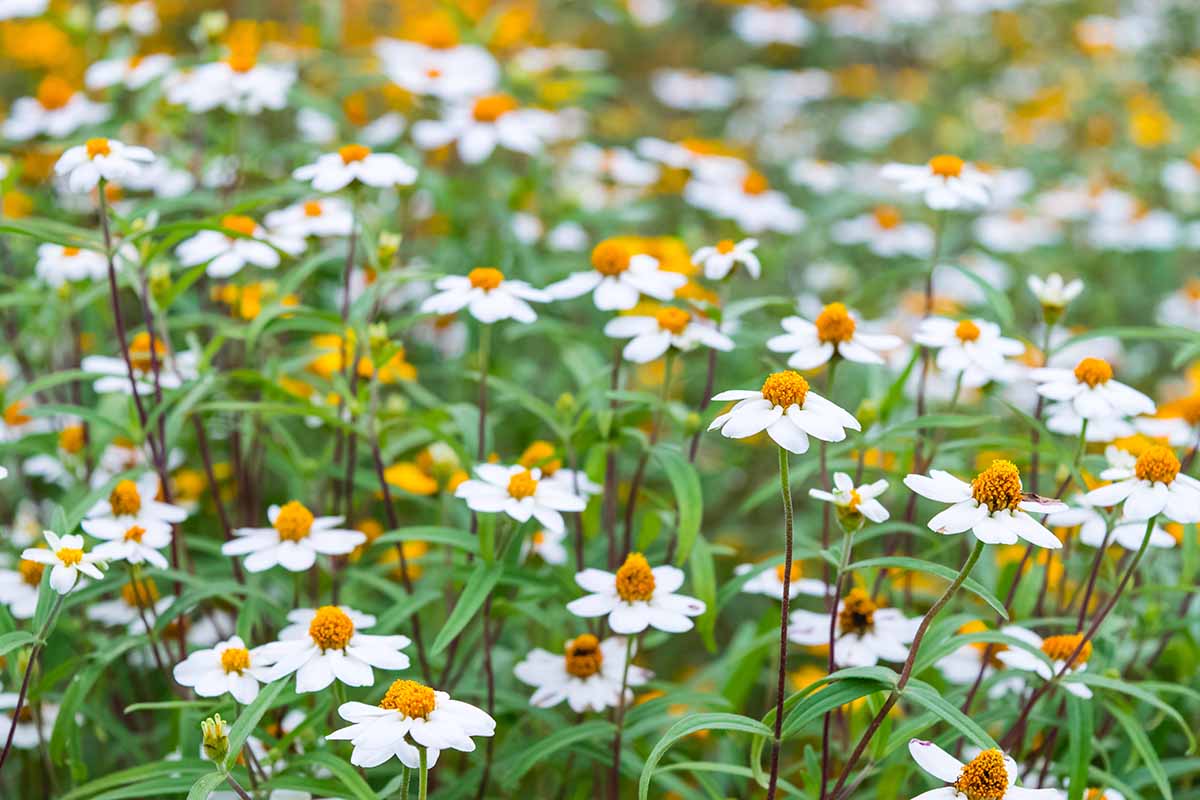
While B. pilosa and B. alba grow almost everywhere, vulnerable endemic species in Hawaii are losing ground due to land development and competition from invasive non-native plants.
A subspecies of B. micrantha known as ctenophylla, and commonly referred to as Ko`oko`olau, is considered endangered in Hawaii.
Landowners are encouraged to protect and cultivate threatened species to help with mitigating their disappearance in the wild.
It can provide insight to have a background of a plant’s historical origins even if we select a variety that is not a native species. Plus, it’s always fun to spot a plant you are familiar with growing in the wild!
Some gardeners might have the desire to investigate native species further. There’s a lot to learn since the genus is vast.
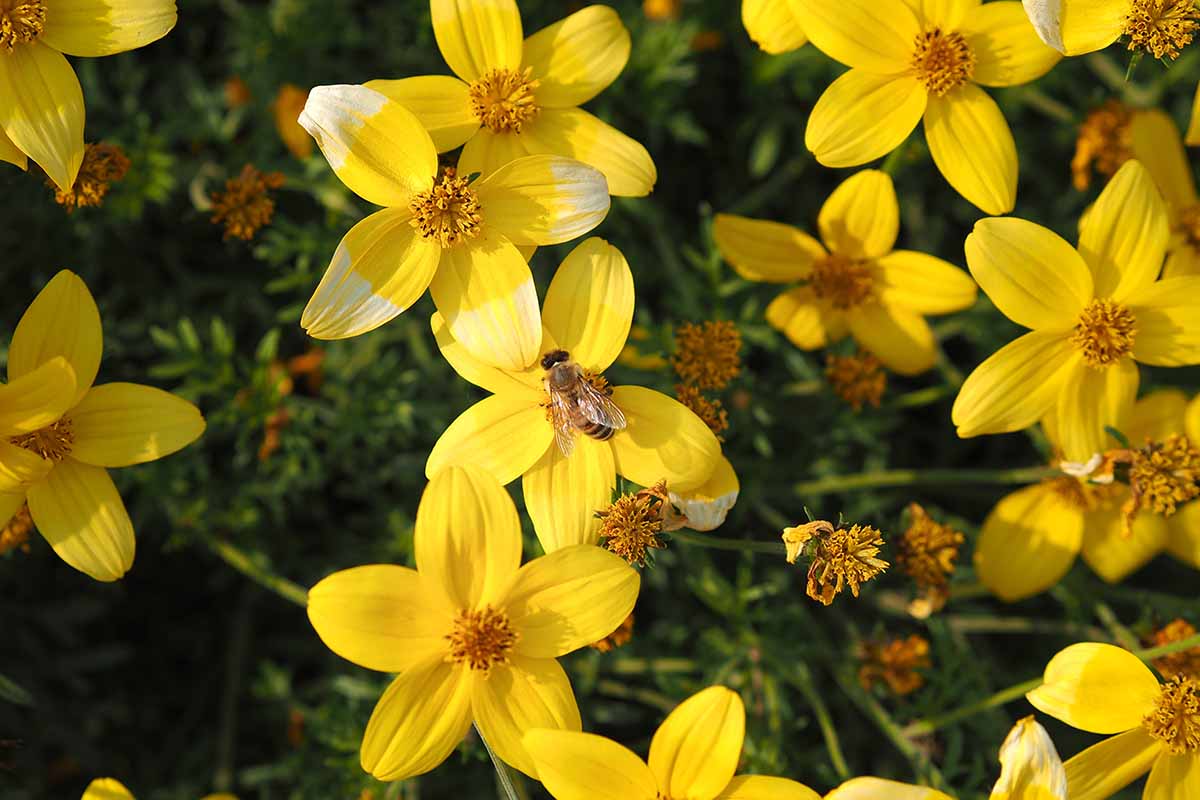
Outside of native species, cultivars with showier blooms have been developed, providing a vast range of planting options that will fit various garden designs.
Continue reading to learn how to easily cultivate Bidens in your garden, and learn more about some stunning selections!
Propagation
Bidens are simple to propagate from seed and cuttings.
I’ve found their seed is not as commonly available as nursery starts are, so if you’d like to start yours from seed, your best option may be to save seed from existing plants or to look online for seed suppliers.
Transplanting nursery starts or seedlings into your garden or into larger containers is easy, given you are planting them in the conditions that allow them to thrive.
From Seed
Since Bidens prefer warm weather, be sure to sow your seeds in an indoor area that is heated. If sowing outdoors, wait until after the last frost has passed and soil temperatures have increased.

In a moist seed-starting mix, surface sow seeds and press them into the soil. To encourage germination, if sowing indoors, place your seed tray in a sunny location and maintain a temperature of at least 65°F.
You can direct sow seeds outdoors after the last frost when temperatures reach the high 60s.
Be sure to maintain even soil moisture. They should begin sprouting in one to three weeks.
From Cuttings
Propagating Bidens from cuttings is a great way to extend their lifespan and to supply your garden with more plants.
Select a three- to four-inch branch that has not flowered or cut off the flowers and buds. Leave only the larger leaves in place and cut off any new, smaller leaf growth.
Root development takes three to six weeks, and can be sped up by using a low-strength rooting hormone.
While wearing protective gloves, dip the bottom of the cutting into the rooting hormone, then carefully shake to remove any excess before placing your cutting into potting soil.
Stick the stalk at least two inches deep into a container of moist potting soil and make sure the soil remains moist.
From Seedlings/Transplanting
Transplant nursery starts or seedlings in spring once the weather has warmed up and there is no frost in sight.
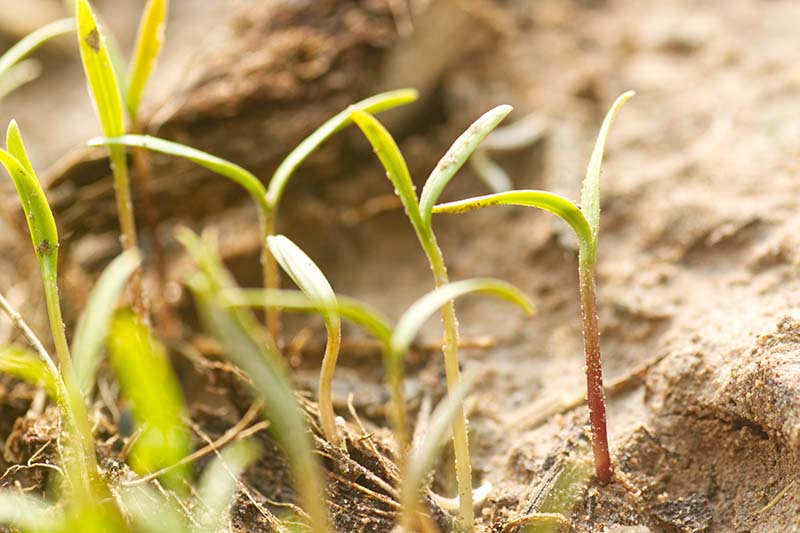
Mix compost into your potting soil or garden bed before planting, or plant them in a medium-sized outdoor planter with good drainage – there’s a wide selection available from ePlanters if you’re looking for something new to plant in.
Space plants one foot apart.
Water every week in the absence of rain until established, with at least one inch of water.
How to Grow
Bidens can become established quickly and require little to no maintenance while in bloom.
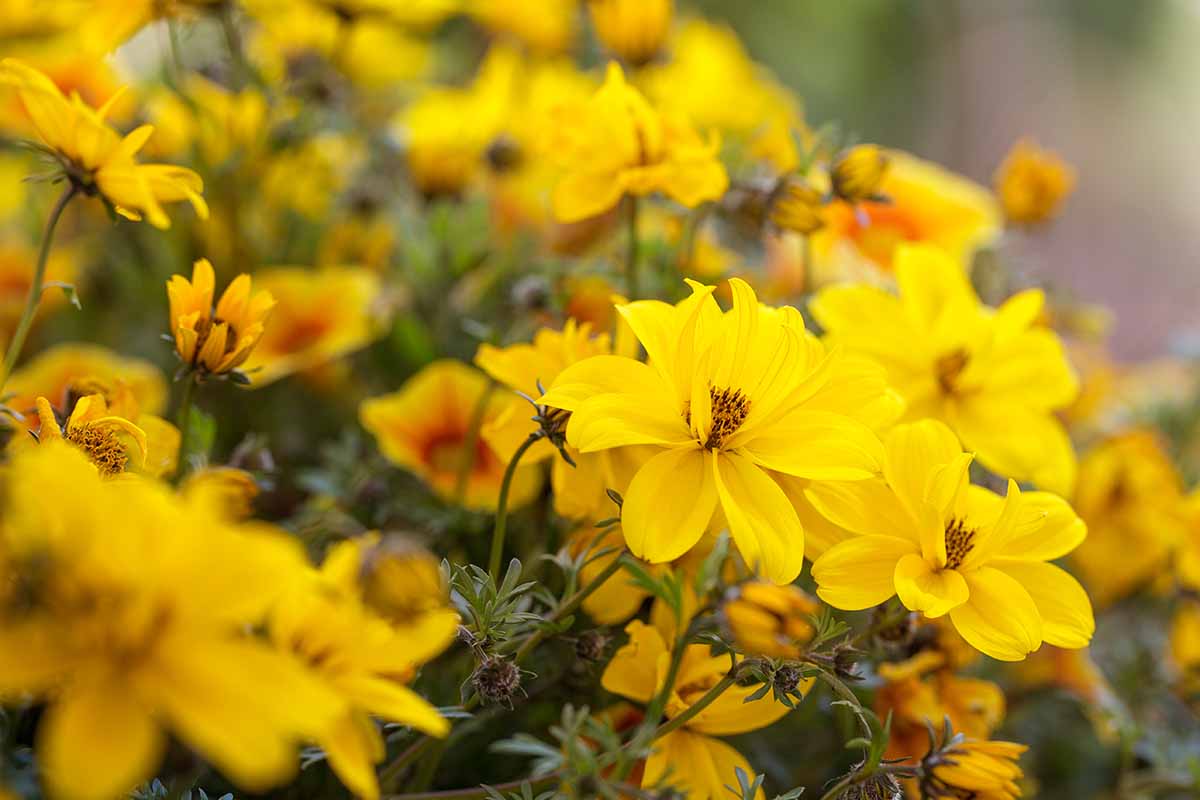
They’ll grow in either partial shade with at least four hours of sun per day, or a full sun location. Aside from that, all they need is rich soil or a monthly application of natural fertilizer and good drainage to perform.
Providing fertilizer encourages a profusion of blooms. Apply it once a month for long-lasting flowers, especially if yours are planted in containers where water runoff can deplete nutrients.
When planting, you could also opt to use a slow-release fertilizer like this one from My Perfect Plants. It’s available in one-pound bags.
Perfect Plants Nutricote Total 360 Fertilizer
To establish a healthy root system, maintain moisture levels by watering weekly. If your plants are not blooming, they likely need more water or some extra sunshine.
If planting a wild species like B. pilosa for a medicinal garden, you won’t have to worry about growing them in soil that’s rich in organic matter – these weedy plants thrive in lean, disturbed soil.
Growing Tips
- Plant in rich soil with excellent drainage.
- Choose a full sun location, or provide at least four hours of sunshine in shaded locations.
- Provide extra water in hot weather for more blooms.
Maintenance
Bidens will flower from May through October and there’s no need to deadhead these prolific bloomers – they take care of themselves when it comes to flowering!
You can periodically pinch them back for fuller and bushier plants if you want to promote branching growth.
If temperatures climb in the summer, they benefit from extra water, and will reward you with more blooms.
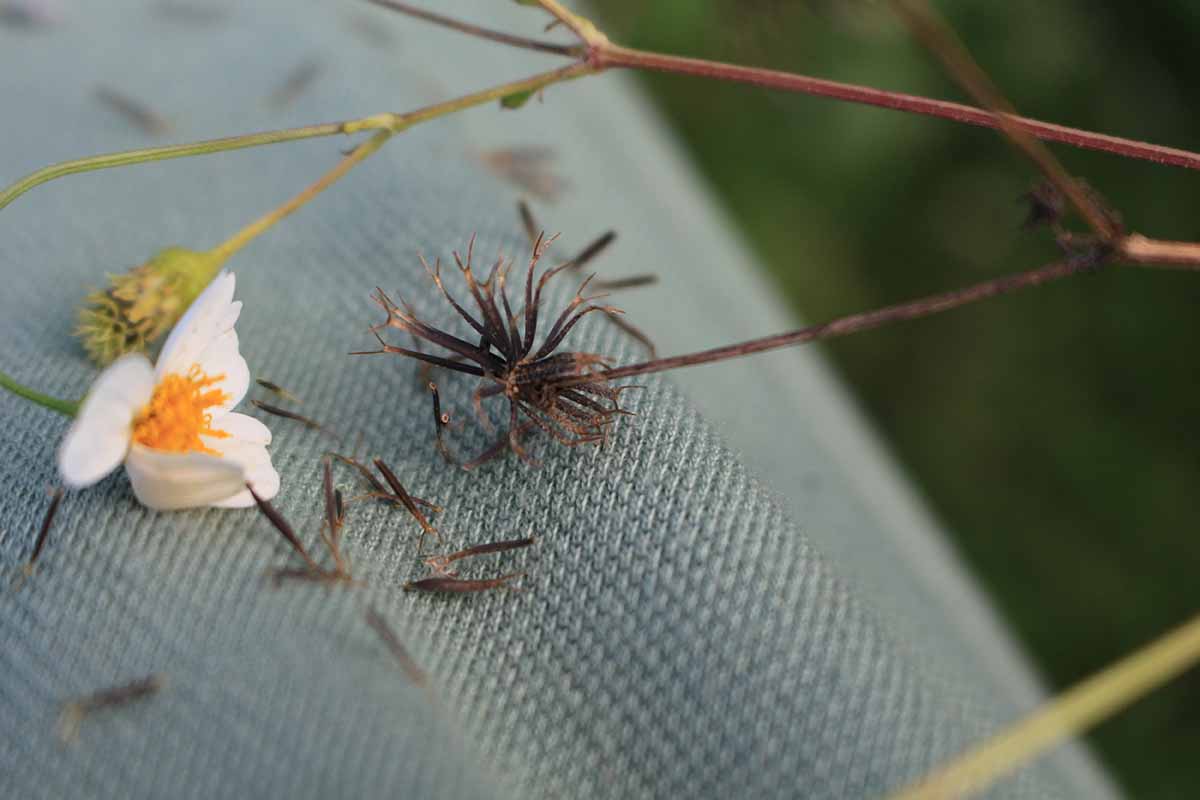
In late fall, you can gather and save seeds to sow in spring. This is especially helpful if you garden in a colder climate where Bidens grow as annuals.
Also, it’s best to be attentive to managing the seed since the burs can irritate people and pets. If you’re planting a newer cultivar, the seeds will typically be less bothersome.
If overwintering in warmer conditions, apply a one- to two-inch layer of mulch for added protection to help your plants bounce back in spring.
Species and Cultivars to Select
B. ferulifolia varieties are commonly planted as ornamentals, especially in hanging baskets. Two beautiful B. ferulifolia varieties for you to consider planting are highlighted below.
B. alba is another recommended species that you won’t want to miss! It’s perfect for those who enjoy a whimsical wildflower design.
Alba
B. alba is for the gardener who likes to keep things wild! This white flower will give your garden a meadow-like appearance while creating a pollinator haven.
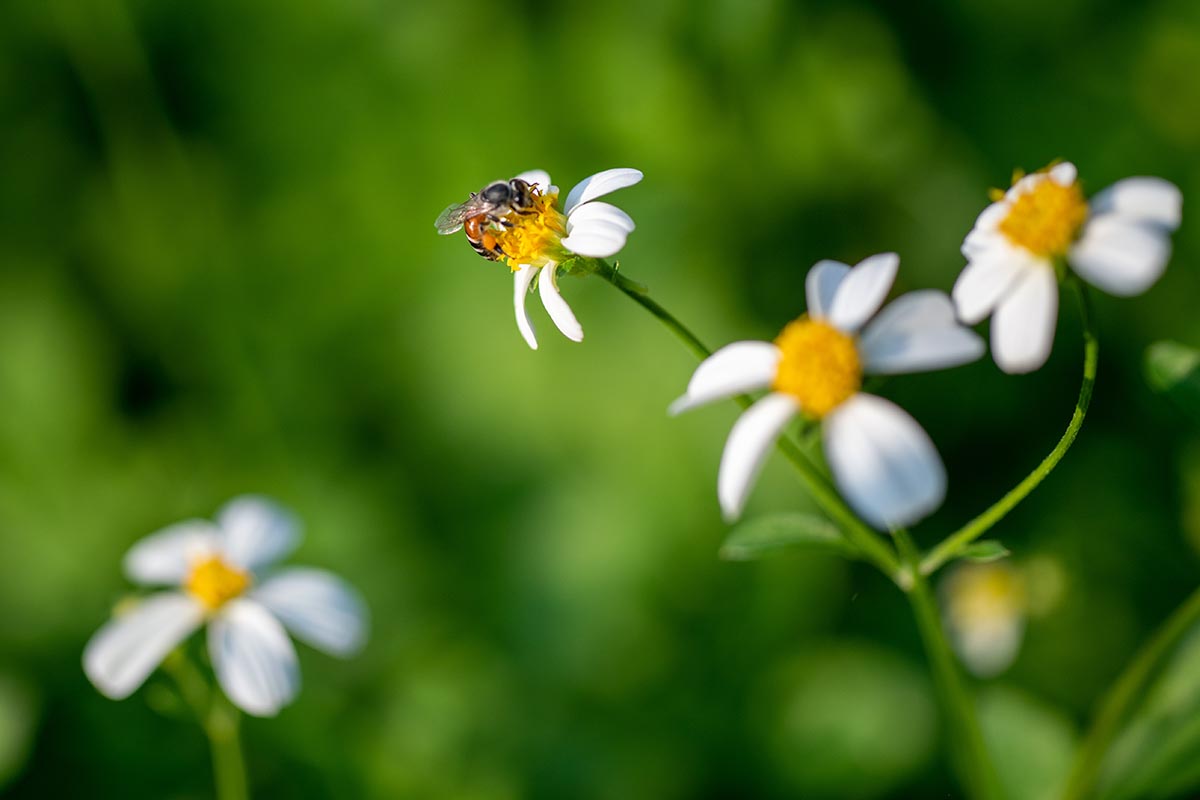
It’s essential to remember that B. alba reseeds aggressively and should be controlled if you don’t want it to take over other growing spaces.
Blazing Fire
The name says it all with this cultivar of B. ferulifolia.
These Bidens have masses of striking flowers that resemble flames from late spring to mid-fall. The dark red color of the flower buds also makes for a stunning display.
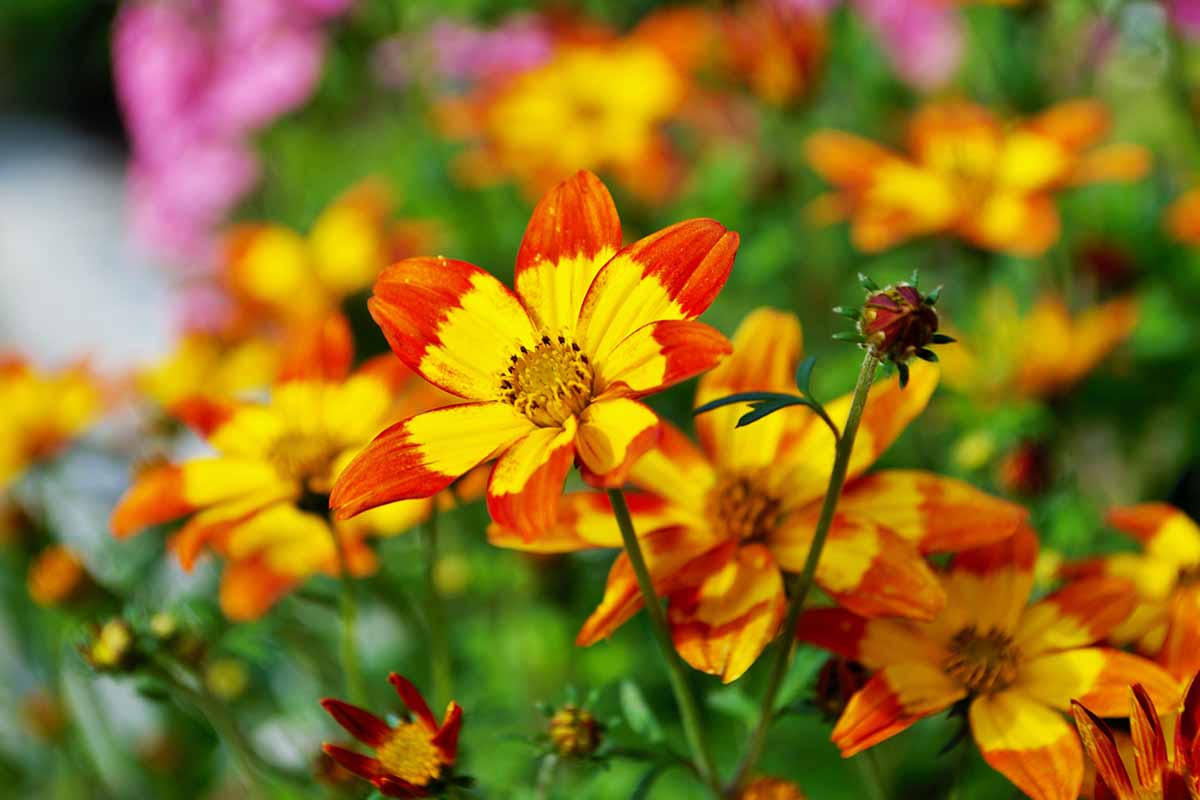
This variety is a vigorous grower that’s highly drought-tolerant.
‘Blazing Fire’ has received the reputation of being a fiery “filler” when invited into planting combinations with “spiller” and “thriller” plants.
Gold Nuggets
Yellow is such a happy color, and it always brings cheer to a garden.
The double daisy-like flowers of B. ferulifolia ‘Gold Nuggets’ glow against the fern-like green foliage when this cultivar is grown in garden borders, containers, and hanging baskets.
‘Golden Nuggets’ is also adored by pollinators and blooms from midsummer to fall.
Burpee offers seeds of this variety in packages of 50.
Managing Pests and Disease
Bidens are resilient, and this extends to them experiencing few issues with pests or disease.
There are a few concerns to be aware of, but they should in no way deter you from planting this flower that is typically hassle-free.
Insects
Two insects that can affect the growth of Bidens are very common in gardens. Infestations can easily be prevented by growing biodiverse plants that attract beneficial insects and pollinators.
Aphids
Aphids are insects that suck the sap from plants, and when they do, they can spread disease.
They may be lime green, red, black, or peach-colored. They also leave behind a sticky film known as honeydew that is appealing to ants, and which can attract sooty mold.
Attracting ladybugs, green lacewings, and birds to the garden with pollinator-friendly plants will keep aphid populations in check.
If an infestation occurs you can spray them off with a strong spray of water from the garden hose, or in the worst case, you could apply a mild soap and water mixture.
Whiteflies
Bidens might experience issues with whiteflies.
Whiteflies suck juices from plants, causing leaves to be yellow, shrivel, and drop prematurely, seriously injuring them.
Encouraging the presence of beneficial insects in your garden will decrease the likelihood of whitefly infestation.
Ladybugs, green lacewing larvae, spiders, and even dragonflies are some examples of beneficial insects and arachnids that can help control whitefly populations. In the case of a bad infestation, prune away damaged parts of the plant.
Learn more about how to diagnose and control a whitefly infestation here.
Disease
Generally, plants grown in appropriate conditions are less vulnerable to disease. If they are cultivated in less-than-optimal conditions, however, they can become stressed and susceptible to diseases that can lead to plant death.
Here are the main ailments to look out for:
Bidens Mottle Virus
This is not a common virus in gardens, but it is one to be aware of nonetheless.
Originally isolated from a specimen of B. pilosa growing in the wild in Gainesville, Florida that exhibited mottling, this virus is transmitted by aphids.
Symptoms of this disease include mottling or yellow discoloration of the leaves, leaf distortion, stunting, and vein clearing, which is when a leaf loses its green color along the leaf vein. In some cases, flowers will not develop.
The best way to prevent infection is to grow a biodiverse garden that supports beneficial insects. Ladybugs in particular can help to manage aphid infestations.
If a plant is infected, remove all infected plant matter from the garden, and thoroughly sanitize any containers.
Botrytis Blight
Botrytis blight is a common disease that might affect Bidens. Also known as gray mold, the fungus enters through plant wounds.
Suppose you notice brown spots on leaves and buds, or darker colored spots on petals – in that case, you’ve caught the disease in its early stages. Once the spots on leaves reveal a fuzzy grayish mold, the infection has progressed.
One of the leading solutions to control the spread of Botrytis blight is good garden maintenance. Remove any discolored plant matter and fallen plant debris near your plants and prevent water from splashing on their foliage.
Once you spot the mold, remove all affected plant parts and throw them away.
Although fungicides might be recommended as a preventative solution, they’re not effective in environments favorable to gray mold. In addition, some gray molds are resistant to certain fungicides.
Pythium Root Rot
Root rot can be a persistent issue in waterlogged soils that have poor drainage. Symptoms of pythium root rot include wilting, irregular plant growth, crown rot, and eventually, plant death.
The best way to prevent the spread of the soilborne pathogen that causes this disease is by cleaning your containers before planting, relying on a trusted soil source, ensuring good soil drainage, and being mindful to not overwater.
When controlling the spread of Pythium diseases, focus on good soil drainage and water management. Remove and discard diseased plants.
Treating the soil where diseased plants were pulled is a good practice, and solarization is a natural treatment that has worked for many gardeners.
To do this, place a thick plastic covering over your soil during hot weather so it reaches a temperature of at least 140°F for at least an hour, to kill the pathogens. You can use a soil thermometer to gauge this.
Best Uses
Bidens provide many planting options. You can invite them into planters and hanging baskets where they will fascinate you with their flowers, or plant them in garden beds as borders.

Use them to enhance drought-tolerant and pollinator-friendly garden designs. You may even be able to cultivate threatened species, to increase their number.
Quick Reference Growing Guide
| Plant Type: | Short-lived perennial or annual | Flower / Foliage Color: | Red, orange, peach, pink, yellow, white/green |
| Native to: | Africa, Asia, Central America, Europe, North America, South America | Tolerance: | Drought, heat |
| Hardiness (USDA Zone): | 8-11 | Maintenance: | Low |
| Season: | Summer-fall | Soil Type: | Fertile |
| Exposure: | Full sun to part shade | Soil pH: | 5.0-7.5 |
| Spacing: | 1-3 feet | Soil Drainage: | Well-draining |
| Planting Depth: | Surface sow (seed), depth of root ball (transplants) | Attracts: | Bees, butterflies, hummingbirds, moths |
| Height: | 6 inches-5 feet, depending on variety | Uses: | Hanging baskets, plant combinations, pollinator gardens, borders, xeriscaping |
| Spread: | 1-3 feet | Family: | Asteraceae |
| Water Needs: | Low, once established | Genus: | Bidens |
| Common Pests and Diseases: | Aphids, whiteflies; mottle virus, Botrytis blight, Pythium root rot | Species: | Alba, ferulifolia |
Bring on the Bountiful Blooming Bidens!
Plant these sun-loving plants in spring for subtly fragrant and colorful flowers in summer that pollinators will adore through fall.
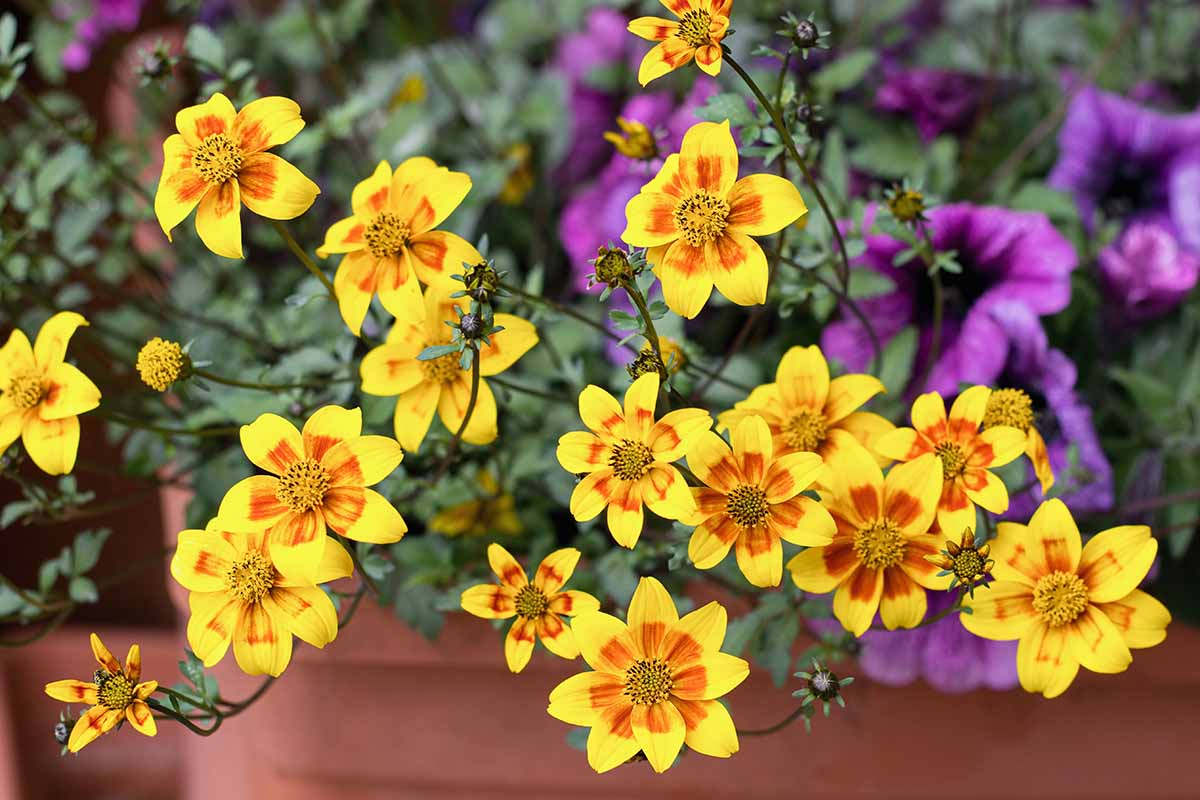
Their lush greenery followed by continual cascading blooms might encourage you to grow more than one variety!
If you believe in cultivating landscapes that support the local environment, give Bidens a go. These species are vital in creating thriving garden habitats.
Are you drawn to these flowers that also bring bees, butterflies, and hummingbirds to the garden? If so, find even more information about attracting pollinators to the garden here:

